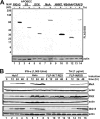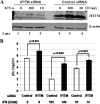Identification of five interferon-induced cellular proteins that inhibit west nile virus and dengue virus infections
- PMID: 20534863
- PMCID: PMC2916517
- DOI: 10.1128/JVI.02199-09
Identification of five interferon-induced cellular proteins that inhibit west nile virus and dengue virus infections
Abstract
Interferons (IFNs) are key mediators of the host innate antiviral immune response. To identify IFN-stimulated genes (ISGs) that instigate an antiviral state against two medically important flaviviruses, West Nile virus (WNV) and dengue virus (DENV), we tested 36 ISGs that are commonly induced by IFN-alpha for antiviral activity against the two viruses. We discovered that five ISGs efficiently suppressed WNV and/or DENV infection when they were individually expressed in HEK293 cells. Mechanistic analyses revealed that two structurally related cell plasma membrane proteins, IFITM2 and IFITM3, disrupted early steps (entry and/or uncoating) of the viral infection. In contrast, three IFN-induced cellular enzymes, viperin, ISG20, and double-stranded-RNA-activated protein kinase, inhibited steps in viral proteins and/or RNA biosynthesis. Our results thus imply that the antiviral activity of IFN-alpha is collectively mediated by a panel of ISGs that disrupt multiple steps of the DENV and WNV life cycles.
Figures







Similar articles
-
A MicroRNA Screen Identifies the Wnt Signaling Pathway as a Regulator of the Interferon Response during Flavivirus Infection.J Virol. 2017 Mar 29;91(8):e02388-16. doi: 10.1128/JVI.02388-16. Print 2017 Apr 15. J Virol. 2017. PMID: 28148804 Free PMC article.
-
The Interferon-Stimulated Gene Ifitm3 Restricts West Nile Virus Infection and Pathogenesis.J Virol. 2016 Aug 26;90(18):8212-25. doi: 10.1128/JVI.00581-16. Print 2016 Sep 15. J Virol. 2016. PMID: 27384652 Free PMC article.
-
Identification of three interferon-inducible cellular enzymes that inhibit the replication of hepatitis C virus.J Virol. 2008 Feb;82(4):1665-78. doi: 10.1128/JVI.02113-07. Epub 2007 Dec 12. J Virol. 2008. PMID: 18077728 Free PMC article.
-
Innate immune escape by Dengue and West Nile viruses.Curr Opin Virol. 2016 Oct;20:119-128. doi: 10.1016/j.coviro.2016.09.013. Epub 2016 Oct 25. Curr Opin Virol. 2016. PMID: 27792906 Free PMC article. Review.
-
How Dengue Virus Circumvents Innate Immunity.Front Immunol. 2018 Dec 4;9:2860. doi: 10.3389/fimmu.2018.02860. eCollection 2018. Front Immunol. 2018. PMID: 30564245 Free PMC article. Review.
Cited by
-
Feedback loop regulation between viperin and viral hemorrhagic septicemia virus through competing protein degradation pathways.bioRxiv [Preprint]. 2024 Jan 10:2024.01.09.574905. doi: 10.1101/2024.01.09.574905. bioRxiv. 2024. PMID: 38260481 Free PMC article. Preprint.
-
Viperin restricts chikungunya virus replication and pathology.J Clin Invest. 2012 Dec;122(12):4447-60. doi: 10.1172/JCI63120. Epub 2012 Nov 19. J Clin Invest. 2012. PMID: 23160199 Free PMC article.
-
Interferon-stimulated genes and their antiviral effector functions.Curr Opin Virol. 2011 Dec;1(6):519-25. doi: 10.1016/j.coviro.2011.10.008. Curr Opin Virol. 2011. PMID: 22328912 Free PMC article. Review.
-
Leukocyte immunoglobulin-like receptor B1 is critical for antibody-dependent dengue.Proc Natl Acad Sci U S A. 2014 Feb 18;111(7):2722-7. doi: 10.1073/pnas.1317454111. Epub 2014 Jan 13. Proc Natl Acad Sci U S A. 2014. PMID: 24550301 Free PMC article.
-
Indoleamine 2,3-dioxygenase mediates the antiviral effect of gamma interferon against hepatitis B virus in human hepatocyte-derived cells.J Virol. 2011 Jan;85(2):1048-57. doi: 10.1128/JVI.01998-10. Epub 2010 Nov 17. J Virol. 2011. PMID: 21084489 Free PMC article.
References
-
- Brass, A. L., I. C. Huang, Y. Benita, S. P. John, M. N. Krishnan, E. M. Feeley, B. J. Ryan, J. L. Weyer, L. van der Weyden, E. Fikrig, D. J. Adams, R. J. Xavier, M. Farzan, and S. J. Elledge. 2009. The IFITM proteins mediate cellular resistance to influenza A H1N1 virus, West Nile virus, and dengue virus. Cell 139:1243-1254. - PMC - PubMed
Publication types
MeSH terms
Substances
Grants and funding
LinkOut - more resources
Full Text Sources
Other Literature Sources
Molecular Biology Databases

